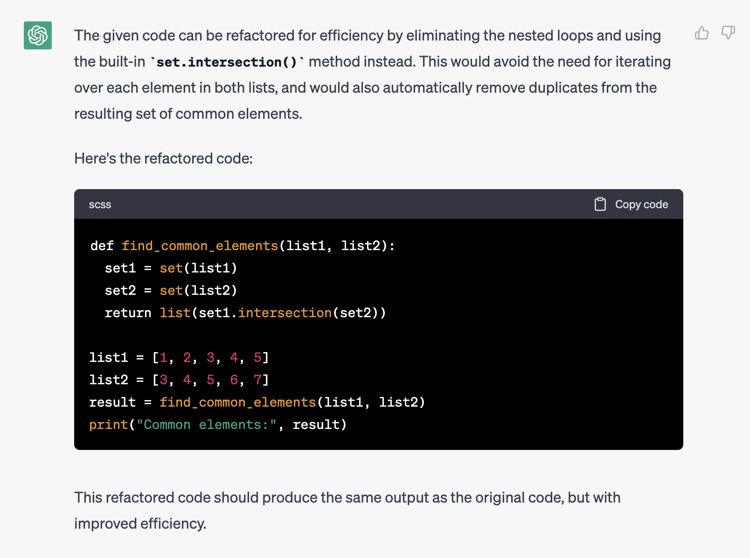Shane Brinkman-Davis Delamore is a master of the craft and passionate about UX design and programmer productivity.
Updated Apr 14, 2023
Generative AI is poised to revolutionize knowledge work, opening up transformative opportunities for humankind. As we stand on the cusp of this new frontier, ChatGPT emerges as an invaluable tool for software leaders and innovators. Even though the tools of generative AI are new, they already offer amazing capabilities that help speed up software projects and free developers to spend their time on the most creative and impactful aspects of their craft. Here are 5 ways you can use it right away.
From the very beginning of a project, ChatGPT can serve as an effective brainstorming partner, helping to surface different ways to solve various challenges. By reducing time spent on research and analysis, developers can focus on effective solutions instead of sifting through countless resources.
For example, if you were considering building a Python web app, you could ask ChatGPT for recommendations based on certain criteria.
I am building a web app using Python and need a recommendation for a framework. My priorities are simplicity, scalability, and streamlined administration.

You could do the same thing for machine learning libraries, cloud services, databases, JavaScript frameworks–pretty much any element of your tech stack.
Once you’ve decided on a path, ChatGPT can also quickly provide suitable options based on your project's requirements. When implementing a technology, ChatGPT offers context-aware guidance to overcome obstacles efficiently, leading to faster implementation and improved code quality.
ChatGPT's ability to generate project scaffolding significantly reduces spin-up times, allowing you to dive into creating value faster. You can easily communicate your needs in natural language and get a custom solution, streamlining the development process and minimizing the time spent on problem-solving.
This capability not only saves time but also helps ensure consistency and adherence to best practices and industry standards across the project. Starting with a standards-based approach can make an app easier to scale, maintain, and update.
Continuing the example above, I asked ChatGPT to help me decide how to implement two-factor authentication in my app. It offered some useful advice along with step-by-step instructions. It even gave me links to the appropriate documentation.
I'm using Django for my Python web app and I need some information about the best way to implement two-factor authentication.

etc...
Even if I don’t decide to go that route, I could easily explore and test multiple approaches in a fraction of the time I might have spent just doing initial research. That means I can focus on the more unique and differentiated aspects of my application–and also get it in front of users much faster, always a priority for us at GenUI.
Various kinds of data manipulation arise as common tasks in software development. For example, you might need to generate test data or convert real data from one format to another. These tasks can be distracting and time-consuming.
ChatGPT excels at these kinds of one-off tasks. For instance, it can generate dummy data.
Generate a table of dummy data containing product names, skus, prices, supplier codes, and inventory numbers

Of course, if you’re working with larger datasets, you’ll quickly hit the limits of what ChatGPT can do. However, for those quick testing and data formatting tasks, it’s extremely handy.
Any experienced developer knows that optimizing code for efficiency can be time-consuming and often requires significant experience and knowledge. If you’re in a hurry, sometimes you have to use what you know. ChatGPT can help you quickly refactor to make good code even better. Here’s a really simple example of calculating squares in Python.
Refactor the following code for efficiency:
def find_common_elements(list1, list2):
common_elements = []
for element1 in listi:
for element2 in list2:
if element1 == element2:
common_elements.append(element1)
return common_elements
list1 = [1, 2, 3, 4, 5]
list2 = [3, 4, 5, 6, 7]
result = find_common_elements(list1, list2)
print("Common elements:", result)
This practice can improve performance, reduce resource consumption, and speed execution times. It also helps you learn as you go so you can write more efficient code next time.
ChatGPT can also help improve code clarity, ensuring that other developers can easily understand and maintain the codebase. By simplifying complex code structures or refactoring code to follow established patterns, ChatGPT promotes long-term maintainability and collaboration among team members.
Proper documentation is an essential part of good software development. However, commenting code and writing documentation can be tedious. ChatGPT helps by generating comments and assisting in creating documentation, ensuring the next developer can easily understand and work with the software.
Automating documentation helps ensure it’s complete and accurate, leading to better collaboration and maintainability. For example, ChatGPT can generate comments for existing code, providing meaningful explanations of complex functions or algorithms. Automated commenting enables future developers to understand the code's purpose and operation without spending significant time deciphering it.
To demonstrate, I asked ChatGPT to generate some complex code without any comments.
Please add comments to this code to explain the purpose of each function:
import random
def f1(s, n):
if len(s) == n:
return [s]
r = []
for i in range(len(s) - n + 1):
r += f1(s[i + 1:], n + 1)
return [s[i:i + n] for i in range(len(s) - n + 1)] + r
def f2(s):
return {x: s.count(x) for x in s}
def f3(d):
r = ''
for k, v in d.items():
r += k * v
return r
def f4(s, k):
r = ''
for i in range(0, len(s), k):
r += s[i:i + k][::-1]
return r
s = 'abodefghijkIm'
n = random.randint(2, 4)
k = random.randint(2, 4)
print(f4(f3(f2(f1(s, n))), k))
It can also assist in creating broader documentation, such as API references, user guides, or architectural overviews. By providing clear and concise explanations, ChatGPT helps ensure that all stakeholders can access the information they need to work effectively with the software.
Taking over an existing codebase can involve a steep learning curve, especially when the code is subpar or poorly documented. Using the tools above, you can quickly understand what the code does, identify potential problems, and get refactoring suggestions to address any issues you find.
Generative AI is poised to play an increasingly important role in the future of software development. Already, it can quickly provide informed suggestions, generate scaffolding for projects, and improve code efficiency in seconds.
In the future, as AI tools become even more sophisticated, smart developers will stay abreast of the latest trends and technologies so they can maximize their potential and performance. With ChatGPT and other advanced tools at our disposal, we are better equipped than ever to create value and drive innovation in this dynamic and ever-evolving landscape.
Can we help you apply these ideas on your project? Send us a message! You'll get to talk with our awesome delivery team on your very first call.